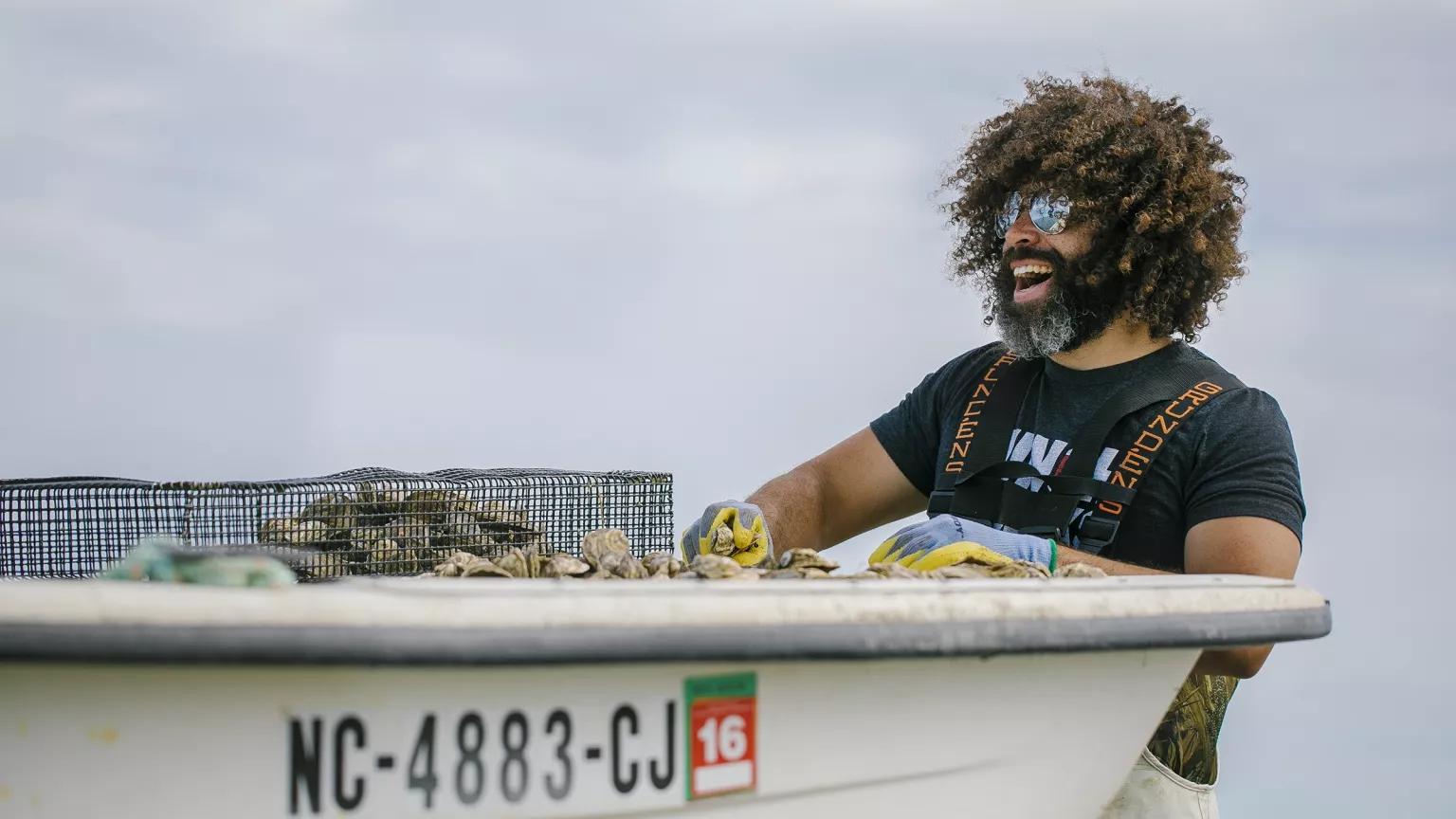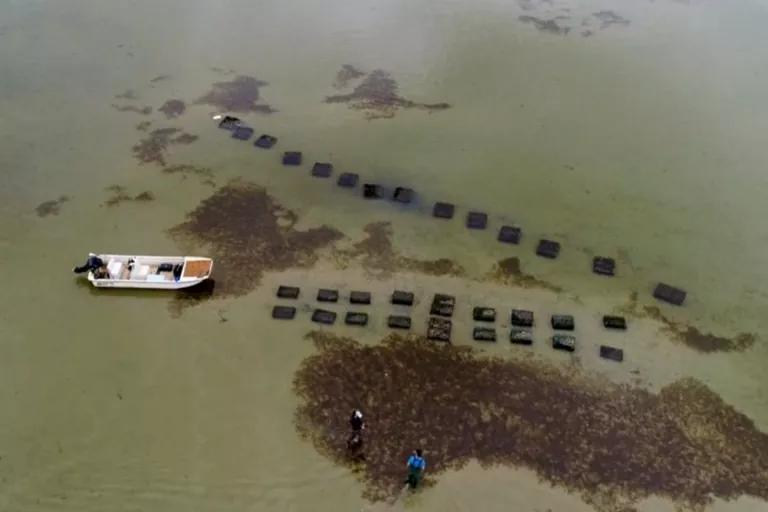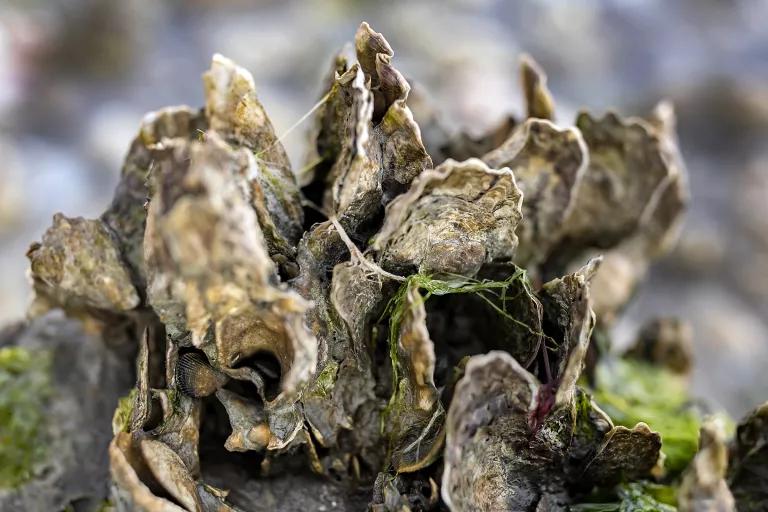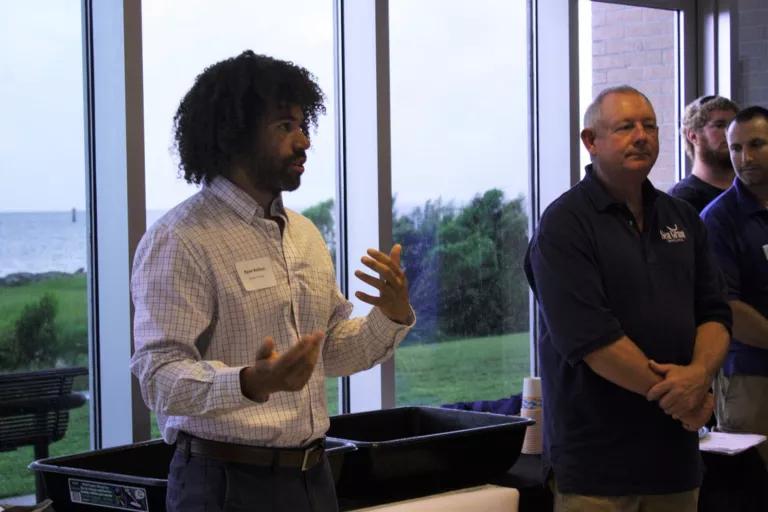Oysters: Raw Bar Delicacy or Climate Warrior?
The mighty bivalves are both, and this former schoolteacher and bartender seeks to inspire a new generation of aquaculturists while putting North Carolina oysters on the map.

Oyster farmer Ryan Bethea
Jeyhoun Allebaugh
Oyster farmer Ryan Bethea spends as much time behind the wheel of a refrigerated truck as he does on the water.
Since 2015, Bethea has been raising salty mollusks on five acres within Westmouth Bay, an estuary off the coast of Harkers Island, North Carolina. All of the hundreds of thousands of oysters grown on his farm, Oysters Carolina, are sold in the Tar Heel State, where Bethea hopes to make fresh oysters affordable and accessible to everyone, “no matter their means or where they live, even if that’s in a food desert.” That’s why he charges just a dollar an oyster and offers free deliveries, from Raleigh to Charlotte to Roxboro to Friendship. The oysters travel from the sea to the kitchen within the same day.
Bethea’s business model has attracted a lot of attention.
“When I started telling people in the industry that I was going to offer free deliveries, they thought I was freaking crazy, and some of them were mad,” Bethea says. “I’m assuming that’s how most industries are when you have a disruptor join.”
In 2011, after reading about the state’s fledgling oyster industry, Bethea, who was a bartender and eighth grade science teacher at the time, decided to make a career change. He enrolled in an oyster aquaculture program at the Virginia Institute of Marine Science, completed two externships, and leased an estuary site—all without any actual field experience raising oysters.
“I’ve always had a lot of pride in North Carolina, and I read the article and thought, I can be part of an industry that would help our state and work on the water growing something that is delicious and environmentally friendly,” he recalls. “It just hit me: This is what I should do.” And now that he’s doing it, Bethea, who identifies as biracial, is tapping into his background in education to inspire the next generation of coastal entrepreneurs, and one that’s more diverse.

Bethea’s oyster-growing cages near Harkers Island
Courtesy of Ryan Bethea
Oysters 101
Farming oysters is fairly straightforward. Bethea purchases oyster seed (i.e., very small oysters) from local farms when they are about one-half inch in diameter. Then he puts the baby oysters in plastic bags that are placed in metal cages on the ocean floor. Every few weeks, Bethea pilots a skiff a mile from shore to the lease site to check on their progress. After cleaning the shells and sorting the bivalves, he moves any larger oysters he finds to bigger bags. The slowest-growing oysters can take up to two years to become large enough to harvest.
On the Oysters Carolina farm, Bethea currently manages 70 cages that together hold 250,000 oysters. And for every one of these animals that Bethea puts in the water, the environment benefits.
Oysters act as natural filtration systems. In fact, a single adult oyster can filter up to 50 gallons of water each day, removing pollutants such as nitrogen that can cause algae blooms. The blooms deplete the water column of oxygen, suffocating fish and leading to decreased animal and plant diversity and poor water quality.
A 2021 report from the North Carolina Coastal Federation found that pollution is the biggest threat to oysters. Runoff containing high levels of bacteria has permanently closed more than a third of North Carolina’s coastal waters to shellfish harvests.
“Oyster farmers are putting tens of millions of filter feeders in the water every year…and providing a great service,” says Chris Matteo, acting president of the North Carolina Shellfish Growers Association. “Filtration is probably the oysters’ number one ecosystem benefit.”
And then there are the reefs themselves, which form when oyster shells fuse together as they grow. These vast structures of shells provide habitat for many marine species, from shrimp and stone crabs to striped bass and speckled trout. According to the National Oceanic and Atmospheric Administration, oyster reefs also act as natural breakwaters, reducing erosion and protecting coastal communities against storm surge and sea level rise.

Close-up of an oyster reef created by researchers at the Institute of Marine Sciences, Morehead City, March 2021
Johnny Andrews/UNC-Chapel Hill
That’s another vital ecosystem service, particularly for a state where sea levels have been rising about an inch every two years due to the impacts of climate change. In addition to experiencing warmer, wetter, and more humid weather, and more frequent and severe hurricanes, North Carolinians are also witnessing a flailing housing market. Oyster farmers hope they can help address at least some of these problems.
In 2019 alone, the North Carolina Division of Marine Fisheries received 106 applications for shellfish leases—a steep increase from the 240 applications it saw over the entire previous decade. The uptick comes at a time when wild oyster populations have been dwindling due to pollution, overharvesting, habitat loss, and hurricanes.
“With a growing population, we can’t meet the demand [for oysters] with wild harvest,” says Bethea. “If we take all [of the wild oysters] out, there will be none left.” Oyster farming helps reduce the harvesting pressure placed on their wild cousins.
“Wild oyster populations are really severely diminished,” says Lisa Suatoni, deputy director of the oceans division at NRDC. “Oyster farms are helping to restore habitat that has been critically endangered while providing significant ecological value.”
The fourth edition of a statewide plan for restoration and protection of oyster populations, “Oyster Restoration and Protection Plan for North Carolina: A Blueprint for Action 2021–2025,” published earlier this year, aims to boost sustainable oyster farming while maximizing the ecological benefits that shellfish provide. Education is key to the plan’s success, and with his experience, Bethea was quick to jump on the opportunity.

Bethea speaking at the North Carolina Shellfish Initiative announcement
North Carolina Coastal Federation
Reef Recruitment
Bethea may have traded cocktail shakers and chalkboards for hip waders but he’s still an entertainer and educator at heart. At fundraisers, conferences, parties, shellfish boils, and other events, he shows off his shucking and slurping skills, all while fielding questions about raising oysters.
“A very small amount of people in Carteret County, where I grow oysters, know anything about oyster farming and, if they knew about it, they would maybe decide to do it,” he says. “We’re always trying to get guys to switch [from commercial fishing] to oyster farming.”
As part of his commitment to education, Bethea hosts tours and gives presentations to civic groups like the Durham Lions Club and the Boys and Girls Club of Carteret County. He dishes up oysters while dishing on the environmental and economic development and career possibilities to visiting students.
“We want to show that you can still live in Carteret County and make money by working on the water while being a good environmental steward,” Bethea says. “We also want to show them that a minority can own a business. It’s not, ‘this person is Black and does this.’ It’s ‘this is an oyster farmer who also happens to be biracial.’ It’s representation in a non-token way.”
He also just revealed his newest venture: A one-acre property on Harkers Island, just a mile from his offshore farm, will be the future site of an education and event center. It’s all part of his goal to support the shellfish aquaculture industry. As the number of oyster farmers keeps growing, Bethea says, “we’re poised to put North Carolina oysters on the map.”
This NRDC.org story is available for online republication by news media outlets or nonprofits under these conditions: The writer(s) must be credited with a byline; you must note prominently that the story was originally published by NRDC.org and link to the original; the story cannot be edited (beyond simple things such as grammar); you can’t resell the story in any form or grant republishing rights to other outlets; you can’t republish our material wholesale or automatically—you need to select stories individually; you can’t republish the photos or graphics on our site without specific permission; you should drop us a note to let us know when you’ve used one of our stories.

How to Become a Community Scientist
Can Anything Be Done to Stop Overfishing?
Biodiversity 101